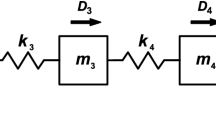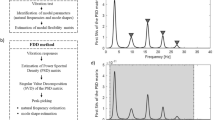Abstract
Sensitivity-based methods by the model updating strategy are still influential and reliable for structural damage detection. The major issue is to utilize a well-established sensitivity function that should be directly relevant to damage. Under noisy modal data, it is well known that the sensitivity-based model updating strategy is an ill-posed problem. The main aim of this article is to locate and quantify damage using incomplete noisy modal parameters by improving a sensitivity function of modal flexibility and proposing a new iterative regularization method for solving an ill-posed problem. The main contribution of the enhanced sensitivity formulation is to develop the derivative of eigenvalue and establish a more relevant sensitivity function to damage. The new regularization method is a combination of an iterative approach called least squares minimal residual and the well-known Tikhonov regularization technique. The key novel element of the proposed solution method is to choose an optimal regularization parameter during the iterative process rather than being required a prior. Numerical simulations are used to validate the accuracy and efficiency of the improved and proposed methods. Results demonstrate that the enhanced sensitivity function of the modal flexibility is more sensitive to damage in comparison with the basic formulation. Moreover, one can observe the robustness of the proposed solution method to solve the ill-posed problem for damage localization and quantification under noise-free and noisy modal data.













Similar content being viewed by others
References
Farrar CR, Worden K (2007) An introduction to structural health monitoring. Philos Trans R Soc A Math, Phys Eng Sci 365(1851):303–315
Farrar CR, Lieven NA (2007) Damage prognosis: the future of structural health monitoring. Philos Trans R Soc London A Math Phys Eng Sci 365(1851):623–632
Entezami A, Shariatmadar H, Sarmadi H (2017) Structural damage detection by a new iterative regularization method and an improved sensitivity function. J Sound Vib 399:285–307. https://doi.org/10.1016/j.jsv.2017.02.038
Lee E-T, Eun H-C (2019) Model-based damage detection using constraint forces at measurements. Eng Comput. https://doi.org/10.1007/s00366-019-00762-9
Ghasemi MR, Nobahari M, Shabakhty N (2018) Enhanced optimization-based structural damage detection method using modal strain energy and modal frequencies. Eng Comput 34(3):637–647. https://doi.org/10.1007/s00366-017-0563-5
Lee E-T, Eun H-C (2015) Damage identification of a frame structure model based on the response variation depending on additional mass. Eng Comput 31(4):737–747. https://doi.org/10.1007/s00366-014-0384-8
Ghiasi R, Fathnejat H, Torkzadeh P (2019) A three-stage damage detection method for large-scale space structures using forward substructuring approach and enhanced bat optimization algorithm. Eng Comput 35(3):857–874. https://doi.org/10.1007/s00366-018-0636-0
Sehgal S, Kumar H (2016) Structural dynamic model updating techniques: a state of the art review. Arch Comput Methods Eng 23(3):515–533
Sarmadi H, Karamodin A, Entezami A (2016) A new iterative model updating technique based on least squares minimal residual method using measured modal data. Appl Math Model 40(23):10323–10341. https://doi.org/10.1016/j.apm.2016.07.015
Entezami A, Shariatmadar H, Karamodin A (2019) Data-driven damage diagnosis under environmental and operational variability by novel statistical pattern recognition methods. Struct Health Monit 18(5–6):1416–1443. https://doi.org/10.1177/1475921718800306
Sarmadi H, Entezami A, Daneshvar Khorram M (2020) Energy-based damage localization under ambient vibration and non-stationary signals by ensemble empirical mode decomposition and Mahalanobis-squared distance. J Vib Control 26(11–12):1012–1027. https://doi.org/10.1177/1077546319891306
Sarmadi H, Karamodin A (2020) A novel anomaly detection method based on adaptive Mahalanobis-squared distance and one-class kNN rule for structural health monitoring under environmental effects. Mech Syst Signal Process 140:106495. https://doi.org/10.1016/j.ymssp.2019.106495
Thai D-K, Tu TM, Bui TQ, Bui T-T (2019) Gradient tree boosting machine learning on predicting the failure modes of the RC panels under impact loads. Eng Comput. https://doi.org/10.1007/s00366-019-00842-w
Mishra M, Bhatia AS, Maity D (2019) A comparative study of regression, neural network and neuro-fuzzy inference system for determining the compressive strength of brick–mortar masonry by fusing nondestructive testing data. Eng Comput. https://doi.org/10.1007/s00366-019-00810-4
Worden K, Farrar C, Manson G, Park G (2007) The fundamental axioms of structural health monitoring. Proc R Soc A Math Phys Eng Sci 463(2082):1639
Mottershead JE, Link M, Friswell MI (2011) The sensitivity method in finite element model updating: a tutorial. Mech Syst Signal Process 25(7):2275–2296. https://doi.org/10.1016/j.ymssp.2010.10.012
Rahai A, Bakhtiari-Nejad F, Esfandiari A (2007) Damage assessment of structure using incomplete measured mode shapes. Struct Control Health Monit 14(5):808–829. https://doi.org/10.1002/stc.183
Esfandiari A, Bakhtiari-Nejad F, Rahai A (2013) Theoretical and experimental structural damage diagnosis method using natural frequencies through an improved sensitivity equation. Int J Mech Sci 70:79–89. https://doi.org/10.1016/j.ijmecsci.2013.02.006
Zhao J, DeWolf JT (1999) Sensitivity study for vibrational parameters used in damage detection. J Struct Eng 125(4):410–416
Sung S, Koo K, Jung H (2014) Modal flexibility-based damage detection of cantilever beam-type structures using baseline modification. J Sound Vib 333(18):4123–4138
Bernal D, Gunes B (2004) Flexibility based approach for damage characterization: benchmark application. J Eng Mech 130(1):61–70
Duan Z, Yan G, Ou J, Spencer BF (2007) Damage detection in ambient vibration using proportional flexibility matrix with incomplete measured DOFs. Struct Control Health Monit 14(2):186–196
Zare Hosseinzadeh A, Ghodrati Amiri G, Seyed Razzaghi SA, Koo KY, Sung SH (2016) Structural damage detection using sparse sensors installation by optimization procedure based on the modal flexibility matrix. J Sound Vib 381((Supplement C)):65–82. https://doi.org/10.1016/j.jsv.2016.06.037
Lee E-T, Eun H-C (2017) Damage detection approach based on the second derivative of flexibility estimated from incomplete mode shape data. Appl Math Model 44:602–613. https://doi.org/10.1016/j.apm.2017.02.014
Yang Q (2009) A mixed sensitivity method for structural damage detection. Int J Numer Methods Biomed Eng 25(4):381–389
Li J, Wu B, Zeng Q, Lim CW (2010) A generalized flexibility matrix based approach for structural damage detection. J Sound Vib 329(22):4583–4587
Yan W-J, Ren W-X (2014) Closed-form modal flexibility sensitivity and its application to structural damage detection without modal truncation error. J Vib Control 20(12):1816–1830
Titurus B, Friswell M (2008) Regularization in model updating. Int J Numer Meth Eng 75(4):440–478
Saeedi A, Pourgholi R (2017) Application of quintic B-splines collocation method for solving inverse Rosenau equation with Dirichlet’s boundary conditions. Eng Comput 33(3):335–348. https://doi.org/10.1007/s00366-017-0512-3
Pourgholi R, Tabasi SH, Zeidabadi H (2018) Numerical techniques for solving system of nonlinear inverse problem. Eng Comput 34(3):487–502. https://doi.org/10.1007/s00366-017-0554-6
Saeedi A, Foadian S, Pourgholi R (2019) Applications of two numerical methods for solving inverse Benjamin–Bona–Mahony–Burgers equation. Eng Comput. https://doi.org/10.1007/s00366-019-00775-4
Wang L, Xie Y, Wu Z, Du Y, He K (2019) A new fast convergent iteration regularization method. Eng Comput 35(1):127–138. https://doi.org/10.1007/s00366-018-0588-4
Weber B, Paultre P, Proulx J (2009) Consistent regularization of nonlinear model updating for damage identification. Mech Syst Signal Process 23(6):1965–1985
Hou R, Xia Y, Zhou X (2018) Structural damage detection based on l1 regularization using natural frequencies and mode shapes. Struct Control Health Monit 25(3):e2107. https://doi.org/10.1002/stc.2107
Grip N, Sabourova N, Tu Y (2017) Sensitivity-based model updating for structural damage identification using total variation regularization. Mech Syst Signal Processing 84(Part A):365–383. https://doi.org/10.1016/j.ymssp.2016.07.012
O’Callahan JC, Avitabile P, Riemer R (1989) System equivalent reduction expansion process. Paper presented at the Seventh international modal analysis conference, Las Vegas, Nevada, USA
Golub G, Kahan W (1965) Calculating the singular values and pseudo-inverse of a matrix. J Soc Industr Appl Math Ser B Numer Anal 2(2):205–224. https://doi.org/10.1137/0702016
Fox R, Kapoor M (1968) Rates of change of eigenvalues and eigenvectors. AIAA J 6(12):2426–2429
Chung J, Palmer K (2015) A hybrid LSMR algorithm for large-scale Tikhonov regularization. SIAM J Sci Comput 37(5):S562–S580
Author information
Authors and Affiliations
Corresponding author
Ethics declarations
Conflict of interest
The authors declare that they have no conflict of interest.
Additional information
Publisher's Note
Springer Nature remains neutral with regard to jurisdictional claims in published maps and institutional affiliations.
Rights and permissions
About this article
Cite this article
Sarmadi, H., Entezami, A. & Ghalehnovi, M. On model-based damage detection by an enhanced sensitivity function of modal flexibility and LSMR-Tikhonov method under incomplete noisy modal data. Engineering with Computers 38, 111–127 (2022). https://doi.org/10.1007/s00366-020-01041-8
Received:
Accepted:
Published:
Issue Date:
DOI: https://doi.org/10.1007/s00366-020-01041-8




